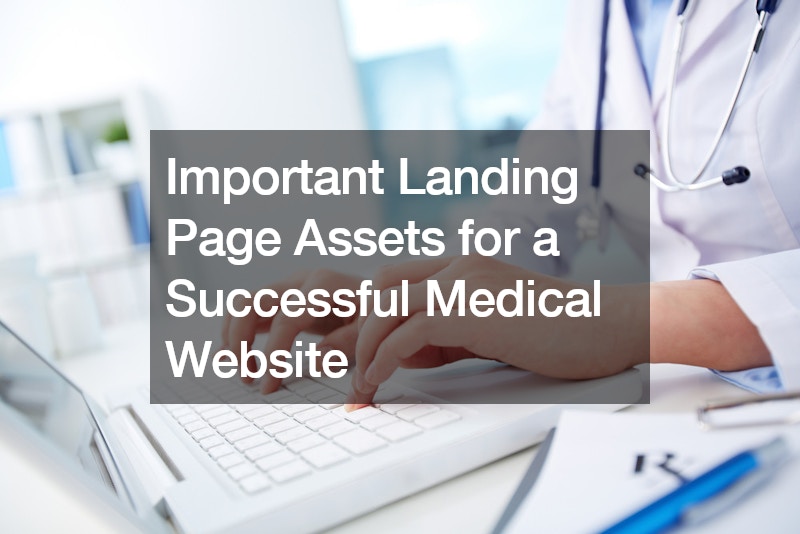
Building a successful medical website requires a landing page that demonstrates knowledge, authority, and a solid message. Anytime you’re building a medical website, you’ll need to take some time to determine which landing page assets are the most important for the information or message you’re trying to convey to your visitors and prospective patients or clients. The more familiar you become with commonly used landing page assets, the easier it’ll be for you to formulate a winning landing page strategy for your medical website, regardless of any subjects or topics you’ll be covering.
High-Quality Logo or Brand Imagery
Whether you’re planning to offer pregnancy surrogate services or if you’re trying to promote cash for diabetic strips, your medical site’s landing page will need to take advantage of high-quality brand imagery and logos. When it comes to landing page assets, logos and brand imagery top the list. Without a proper logo, brand colors, or imagery surrounding your business, it will be extraordinarily difficult to appeal to prospective customers and clients, regardless of how relevant your content, products, or services are to your online visitors.
Investing time in developing a high-quality logo that conveys a message that best represents your brand can have a significant impact on the results you receive online. When you think of popular brands today such as McDonald’s and even Starbucks, you’re likely able to easily conjure up an image of their nostalgic logos and brand colors. Anytime you want to build a medical website with credibility and impact, you’ll need to take your visual appearance and branding very seriously.
Clear Headline or Headers
One of the most important landing page assets that you’ll need to keep in mind while constructing a medical website includes the headlines and headers you choose to use. Whether you’re promoting biohazard waste disposal services or a specific hearing aid product you’re endorsing as a doctor, the right headers and headlines can make a world of difference. Anytime you’re building a website, headlines and headers within ‘heading’ HTML will ‘weigh’ more in top search engines, such as Google, Yahoo!, DuckDuckGo, and even Bing.
To determine which headers and headlines you should utilize, you’ll need to take some time to research trends in the medical industry or subculture you intend to exist in. For example, if you’re developing a dental implants website, you’d want to spend some time watching videos on dental implants or reading articles so that you understand the customer questions and concerns when getting dental implants. You can use a variety of online tools and platforms to research keywords and trends, including Google Trends, which is accessible to the public free of charge. Following the latest trends in the medical industry can also help determine which keywords may be optimal for your headers and main keywords you intend to target while sharing content and blogs.
Mobile Optimized Design
Today, when creating a medical website, another one of the most vital landing page assets to include is a mobile-optimized design. In the past, the majority of users online browsed with the use of a traditional web browser, oftentimes on a desktop computer or laptop. Now, that has switched to the use of smartphones and tablet devices.
Whether you’re an orthodontist looking to promote your latest location or you’re providing addiction treatments to locals in a particular community, you’ll need to do so with a mobile-optimized website layout and landing page in place. Optimizing your landing pages for mobile smartphones and tablet devices will prevent you from alienating the majority of your audience in some cases, depending on the demographics you’re targeting and trying to reach in the medical industry. When a website is accessible across all operating systems, browsers, and devices, it’s much easier to ensure its success, even if you’re entering the highly competitive market of health and medicine.
Suitable Brand Voice and Messaging
From promoting available physiatry jobs to offering dental implants, anytime you’re creating a medical website, you’ll need to include suitable brand messaging on any landing pages you build. When you’re building a landing page for a medical website, you’ll need to consider the immediate message you’re sharing, how visitors are greeted, and the imagery or branding used to spread that message. With the use of focus testing and A/B testing, it’s also possible to create multiple landing pages to determine which page is best for your audience and the image you want to present.
To better understand the importance of brand messaging and visual appeal, take some time to research local competitors in the medical industry near you. Understanding how local medical providers and companies present themselves online with their official websites, blogs, and social media, can help you better formulate a plan of your own. The more comfortable you are with navigating a website, the less likely you are to search for an alternative source or provider.
A medical website that provides clear, direct, and concise messaging will have a much greater chance of success than a website that lacks clear headers, imagery, and establishing a solid message. If you’re new to building websites and want to ensure the best outcome possible, you’ll need to better understand how successful sites in your market and industry operate. Immersing yourself in navigating your competitors’ sites is one of the best ways for you to spark ideas and seek inspiration for your own medical site’s presence and appearance.
Interesting, Unique, and Useful Content
Anyone who is concerned about vital landing page assets should also consider the type of content they intend to create, share, and promote. Whether you’re a certified and licensed pediatrician that is helping children with sore throats and scrapped knees or if you’re planning to promote the latest in body sculpting exercises with your sculpting business, establishing yourself as an authoritative source is crucial anytime you’re building a website in the medical industry. When it comes to promoting a business today, especially when you intend to do so online, content is still king.
The right content strategy will help promote any informative blogs or articles you intend to share on your official website with the use of the landing page you’re creating. The more fleshed-out your blog is, the easier it’ll be for you to appear professional, authoritative, and trustworthy in the medical field, especially to new visitors online. Once you make the decision to begin crafting content to promote your website and landing page(s), you’ll want to determine which categories will be most appealing to your visitors and prospective customers or clients.
Conduct a bit of research to determine which trends, technologies, and even treatments in your field of expertise are most relevant at the current time. Research competing blogs and websites to gain valuable insight into the types of blogs that are being written and promoted by those near you or those in the same industry and market as you. The more immersed you are with the medical industry as a whole and the subcultures you’re focused on, the easier you’ll find to craft a winning content strategy of your own once you’re ready to do so online.
Social Media Links and Pages
Another one of the most crucial landing page assets that should not be ignored includes social media links and page icons. Social media is one of the greatest marketing tools to be invented with the use of the internet, as it provides just about everyone an equal opportunity to promote their services, companies, brands, and ideas from one central location. Including links to your social media pages and content you’ve shared will not only help you reach as many people as possible, but it’ll also help you boost your landing page’s SEO, or its search engine optimization.
You can integrate social media links and icons into your landing page with the use of basic scripts, third-party applications, or even with traditional HTML links and images, depending on your preferences. You will also need to keep in mind which platforms you’ll be promoting and why. When you’re adding social media links and icons to your landing pages, be sure to do so only once you’ve researched the best locations for the social media icons based on the current layout or design you intend to use.

Strong CTA (Call-to-Action)
One of the most vital elements to remember when it comes to landing page assets for medical websites includes a strong CTA, or a call-to-action. Whether your medical website’s intention is to promote healthcare services, supplements, vitamins, or even specific devices and treatments, you’ll want to inform your users of your intention with a strong CTA that not only makes sense, but also resonates with your intended audience. The use of a strong CTA can mean the difference between turning prospective customers and clients away and gaining a lifelong patient, depending on what you’re promoting at the time.
If you’re new to developing medical websites and landing pages, you may want to compare different sites that are also in the same realm or industry as you, especially when it comes to healthcare and medicine. This will allow you to become familiar with common CTA buttons, messaging, and methodologies that tend to work in the medical industry. You can also research CTA formatting to determine where you should incorporate the location of your preferred CTA on your medical site’s landing page.
Contact Details
Before you publish any landing page for your medical site, you’ll also want to include your contact details. This step is crucial if you’re a healthcare professional who is interested in establishing yourself as an authoritative or trusted source, especially if you’re new to a location or region you’re promoting your services in. Including contact details on any landing page you create for your medical website will increase your chances of receiving calls, new patients, or orders from those who have a genuine interest in learning more about your site and what it has to say.
Including contact details on your medical site’s landing page, it is possible to do so by selecting a layout and design that is appropriate for the purpose and intention of your site. In some instances, it may be best for you to include contact details in the top navigation bar of your website. For other landing pages, contact details may be placed towards the bottom of a site, which is useful once a visitor has read all the information and details on the landing page itself.
If you’re new to developing landing pages for medical websites, but you want to ensure yours is as optimized and successful as possible, you may want to work with a professional designer or developer. Working with a graphic designer or web developer can help ensure your landing page is not only attractive, but also optimized for all web browsers, devices, and various electronics across the board before it is live.
Regulations and Compliance (If Applicable)
Depending on the sector of the medical industry you intend to represent online, there may be specific regulations and compliance guidelines that need to be followed, especially if you’re offering services or selling medical devices with the use of an eCommerce store. Before you build and launch a medical website or a landing page, you’ll want to take the time to learn more about any existing statewide regulations or compliance laws regarding your industry and the products, services, or ideas you intend to promote. Abiding by compliance laws and regulations can prevent potential cease and desist orders, fees, fines, and the removal of your website from popular search engines, including sites such as Google.
Anytime you’re thinking of going into the field of medicine or healthcare, abiding by compliance regulations and existing laws is essential. It is not only imperative to prevent fees and fines from a business perspective, but also to ensure the health and safety of your patients, clients, and customers. Whether you’re thinking of promoting a new supplement or a healthcare device, you’ll only want to do so once you’ve verified your legal right to do so without breaking any compliance laws or regulations in place.
Using the right landing page assets can make a significant difference in the number of online visitors to retain and those you turn away immediately. When you’re familiar with common and popular landing page assets, you can begin building a website framework or layout that is truly reflective of the purpose of your future medical site. Whether you’re selling products or promoting a local clinic, a suitable landing page is sure to render the results you’re looking for as a professional.







